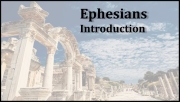Ephesians Series Part 3

Yesterday we looked at the structure of the first 14 verses of Ephesians chapter one, and today we’ll have a look at the rest of the chapter. Next week we’ll take a closer look at the message Paul delivers and the theology that it teaches.
In verse 15 we see Paul shift from the “we\our” and “you” language to a more personal form of writing. This shift in tone, however, does not mean a shift in topic. Remember that all of chapter one is a single sentence in the Greek, so regardless of how your translation may divide these passages there is no division in the original context. Indeed, verse 15 starts out with the phrase “for this reason”, meaning all that has come before is relevant to what he about to reveal next.
Read more: Ephesians Series Part 3
Sermon on the Mount, Part Four

Last week we mentioned that Jesus had two key concepts emphasized in the Sermon on the Mount. Last Thursday we learned the first of these was persecution; today we learn the second. The second key concept is: Rejoice when persecuted.
Read more: Sermon on the Mount, Part Four
Sermon on the Mount, Part 1

We’ve spent the last couple weeks examining characteristics of royal peoples as they apply to Christians, a people who are unique in that they too are royalty but of a kingdom that is not yet manifest in our world. I can’t think of a better place to start learning about becoming Heavenly Kingdom royalty than to understand The Beatitudes. Jesus’ Sermon on the Mount is one of the most familiar passages in the New Testament. The passage contains what is commonly called “the Beatitudes”. The beatitudes are remarkable in their clarity of meaning, and yet are often completely misunderstood.
Read more: Sermon on the Mount, Part 1
2 John

John’s second letter followed closely on the heels of the first, so we find many of the same themes and the same problem being addressed -- namely the false teachings of Cerinthus. Once more we find the apostle John not clearly identifying himself by name, but rather by literary style and through tradition. This is characteristic of all of John’s epistles and unlike his gospel and book of revelation. The big idea John communicates in this epistle is also similar, only instead of Fellowship with God leading to obedience and a love for their brothers and sisters he proclaims that love for God results in obedience and the ability to resist false teachings.
Read more: 2 John
Ephesians Series

I’ve always enjoyed this particular epistle. So much so that when my college professor for an advanced Greek reading course asked me to choose a book to translate that summer, I picked this particular letter. He grinned widely and I knew I must have made a mistake. “Should I choose something else?” I asked. “No no,” he said with an innocent face. “It’s a great choice. Come back next week with Chapter one translated.” His devilish smirk had a reason. What I didn’t know, couldn’t know until I looked at it, is that all of chapter one is a single sentence. Yep, one long run-on sentence which makes translating it particularly difficult.
Read more: Ephesians Series
Sermon on the Mount, Part Three

Yesterday we left off announcing that there are two key concepts Jesus teaches during the Sermon on the Mount. The first of these concepts is: Realize persecution WILL happen. Jesus tells us in Matthew 10.22 that “All men will hate you because of me…” And Paul tells Timothy “In fact, everyone who wants to live a godly life in Christ Jesus will be persecuted…” (2 Timothy 3.12). This truth prompts two questions: do you desire to live a godly life in Jesus? When was the last time you were persecuted?
Read more: Sermon on the Mount, Part Three
Situational Holiness

A favorite topic of many a pastor is lifestyle evangelism, but I’d prefer to talk about the evangelist’s lifestyle. Rather than discussing a process I’d like to determine a heartbeat. I want to move us beyond mere instruction and to a place of holy living, for a Christian can make no greater impact on the world than to be holy (1 Peter 1.15-16). Paul agrees with Peter when writing to the Church of Corinth:
Read more: Situational Holiness
1 John 5

As previously mentioned, at this time in John’s life he is getting up in years. His writing reflects a circular reasoning, coming back to a few key elements again and again, constantly repeating what is most important. But like an aging grandparent, we know he is motivated by love. In fact, love gushes from the whole book. Here a restatement of the letters Big Idea is necessary: Fellowship with God the Father and the Lord Jesus Christ cause believers to live in obedience to the Word and in love for their brothers and sisters in Christ. John tells us this Big Idea is important for two reasons:
Read more: 1 John 5
Ephesians - Introduction

This week we start a new series on the book of Ephesians. One of Paul’s “prison epistles,” Ephesians was written alongside the letters Philippians, Colossians and Philemon about ad 60-62. The Ephesian church was built five years previous to this letter, and became the central hub of Christian missions. Ephesus was a costal metropolis which thrived under Roman rule. At it’s sea ports stood the temple of Diana, 425 feet long, 220 feet wide, to greet all travelers arriving by ship. Because it held one of the Seven Wonders of the World it was also an area heavily populated with metal workers who would form Diana replicas, charms and amulets of all kinds.
Read more: Ephesians - Introduction
Sermon on the Mount, Part Two

Jesus continues to teach using the third person until he gets to the passage we are studying in more detail today, verses 10, 11 and 12. You will notice that there is a shift in verse 11 where Jesus stops speaking in the third person and starts speaking in the second. But before we get into the meat of what Jesus is teaching in these three verses, I want to make sure we understand what Jesus is intending in all the beatitudes.
Read more: Sermon on the Mount, Part Two
3 John

Like II John, the author’s only reference to himself is the “elder.” There are, however, clear stylistic ties between all three letters, as well as the tradition of early church fathers, which attribute all three epistles to the apostle John. Once again, there is little evidence of the time of composition, but it is reasonable to suggest that all three were written sometime in the early (AD) 60’s. III John differs from the first two letters, however, as it is a personal correspondence to a single individual, rather than a church. It seems to suggest that, despite the possibility of incurring the wrath of his church bishop, Gaius ought to welcome the bearer of the letter to his home as a servant of the Lord. John tells of his disappointment with Diotrephes, and suggests that he will set things right on his next visit. The big idea of this letter is clear: A knowledge of God is evidenced in faithfully attending to God’s people, regardless of the consequences. A fitting message for today’s pastors.
Read more: 3 John
1 John - Testing Teachers

In this section of John’s epistle, he wants to make sure his point is not lost on his readers. At the end of verse 10, John states how one must love his brother if he is to be identified with Christ. Now in verse 11 he will state it positively, and this phrase he will use four more times in the book: “Love one another.” Look again to verse seven of chapter four, and you will find once more, “Love one another, for love comes from God.” Yet again, in verse 11, “Dear friends, since God so loved us, we ought to love one another.” In the very next verse, verse 12, he tells us once more what this action proves: “…if we love one another, God lives in us and God’ love is made complete in us.”
Read more: 1 John - Testing Teachers












